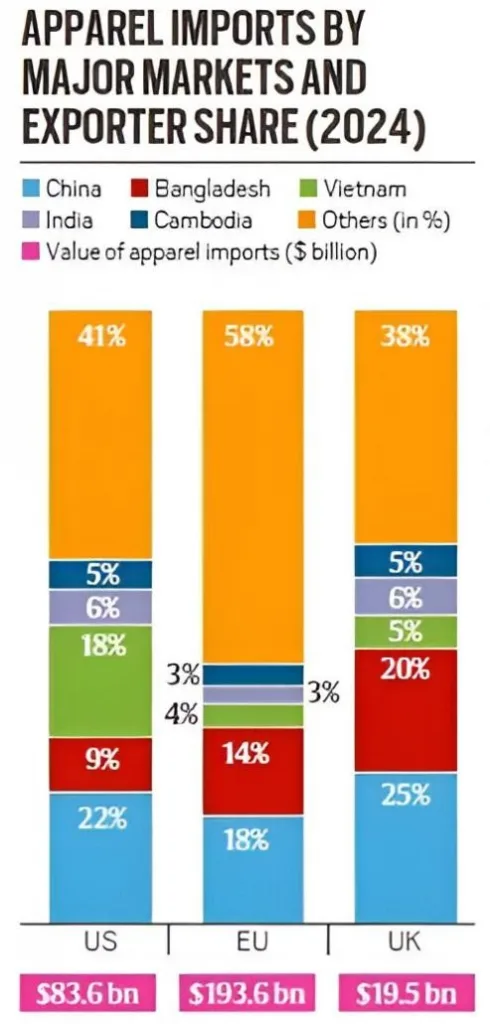Syllabus: GS2/International Relation; GS3/Economy
Context
- The recently signed India-UK Free Trade Agreement (FTA) is expected to enhance exports, create jobs, and strengthen supply chains, with India’s textile sector being a key beneficiary.
About the Free Trade Agreement (FTA)
- It is a bilateral or multilateral trade pact that eliminates or reduces tariffs, quotas, and trade barriers between participating countries, fostering economic cooperation and market access.
Key Points in the India-UK FTA
- Zero-Duty Access for Indian Exports: The deal eliminates import tariffs on over 99.3% of animal products, 99.8% of vegetable/oil products, and 99.7% of processed foods, making Indian goods more competitive in the UK market.
- Expanding Trade Partnership: The UK currently imports goods worth $815.5 billion, primarily from China (12%), the US (11%), and Germany (9%).
- India holds about 1.8% share ($15.3 billion) in UK imports, ranking as the UK’s 12th largest trading partner.
- India-UK Trade Goals for 2030: As of 2024, India-UK trade in goods amounted to $23.3 billion, with $8.06 billion in UK exports to India.
- The FTA sets an ambitious target of reaching $120 billion in trade by 2030.
- UK Export From India: Pearls, nuclear reactors, spirits, and vehicles.
- UK Import From India: Machinery, mineral fuels, pharmaceuticals, apparel, and footwear.
- Strategic Trade Partnerships: The agreement strengthens the India-UK Comprehensive Strategic Partnership, fostering trade, investment, innovation, and job creation.
- India is negotiating FTAs with the EU and the US, targeting duty-free access to high-value markets.
| India’s Textile & Apparel Sector – It contributes 2.3% to our GDP, 13% to industrial production, and 12% to exports. – It is the second largest employment generator, after agriculture, with over 45 million people employed directly. – India is the 6th largest exporter of Textiles & Apparel in the world, and exports textiles to over 100 countries, with a 4.5% share in global trade. – India exported textile items worth US$ 34.4 billion in 2023-24, with apparel constituting 42% of the export basket, followed by raw materials/semi-finished materials at 34% and finished non-apparel goods at 30%. 1. It is projected to reach $350 billion by 2030. Government Initiatives for Growth – PM MITRA Parks: Integrated textile parks to streamline production and exports. – Kasturi Cotton Initiative: Branding and certification to enhance Indian cotton’s global value. – National Technical Textiles Mission (NTTM): Focuses on research, innovation, and skill development in technical textiles. |
India’s Advantage: India-UK FTA
- India’s textile and apparel industry, employing over 45 million people, stands to gain greater access to high-end UK markets.
- The FTA eliminates tariffs on apparel exports, making Indian products more price-competitive.

- Current India’s Market Share With UK: The UK imports $26.9 billion worth of Textile & Apparel products annually, with $19.6 billion dedicated to apparel.
- China dominates the market (25% share, $4.9 billion), followed by Bangladesh (20%, $3.9 billion).
- India holds a modest 6% share ($1.19 billion), leaving significant room for expansion post-FTA.
Structural Challenges Facing India’s Textile & Apparel Sector
- Fragmented Manufacturing Base: Micro, Small, and Medium Enterprises (MSMEs) operate in silos across multiple states, limiting efficiency and coordination.
- Disjointed Value Chain: Cotton is grown in Gujarat and Maharashtra, yarn is spun in Tamil Nadu, fabric is processed elsewhere, and garments are stitched at different locations.
- It raises logistics costs and causes delays—India’s order-to-delivery cycle takes 63 days, compared to 50 days in Bangladesh.
- Policy Limitations on MMFs: India’s MMF segment lags behind global preferences, hindered by an inverted GST structure where fibre inputs are taxed higher than finished products, making Indian MMF garments globally uncompetitive.
Policy Interventions Needed for Growth
- Swift Operationalization of PM MITRA Parks: Government-backed PM MITRA parks, particularly in Navsari (Gujarat) and Virudhunagar (Tamil Nadu), must be expedited to boost textile exports.
- Simplification of Export Compliance: Streamlining complex regulatory processes and eliminating compliance-heavy hurdles can significantly improve trade efficiency.
- Rationalizing GST Duty Structure in MMFs: A revised GST framework is crucial to level the playing field, allowing Indian MMF apparel to be price-competitive internationally.
- Strategic Trade Negotiations Beyond the UK: While the India-UK FTA offers zero-duty access, India must secure duty-free entry into the EU ($193.6 billion apparel market) and the US ($83.6 billion apparel market).
- Bangladesh and Vietnam enjoy duty-free access to the EU, whereas the US has significantly reduced Chinese dominance through high reciprocal tariffs—offering India a rare opportunity to capture market share.
Closing the Gaps
- High-Value Apparel Design: Indian manufacturers must focus on premium designs to appeal to UK buyers.
- Supply Chain Efficiency: Enhancing production speed and quality control will increase export volumes.
- Sustainable and Ethical Standards: Adapting to UK regulations on environmental sustainability and fair labor practices will improve market acceptance.
Enhancing Practices and Product Innovation
- Meeting Global Fashion Aesthetics and Compliance Standards: The EU’s Corporate Sustainability Due Diligence Directive (CSDDD), set for 2029, will require Indian suppliers to adopt ESG compliance, traceability, and green audits.
- Compliance with UK Standards: Indian exporters need to align with UK regulations on sustainability and ethical sourcing.
- Scaling Up Value-Added Textile Segments: India needs to focus on activewear, athleisure, and technical textiles, which dominate the global MMF market.
- Investing in functional and performance fabrics will allow Indian firms to integrate into premium retail supply chains.
Conclusion
- The India-UK FTA presents a transformative opportunity for India’s textile sector, offering tariff benefits, employment growth, and stronger trade partnerships.
- Timely adaptation to market trends and sustainability standards will ensure long-term success for Indian textile exports.
| Daily Mains Practice Question [Q] How can the India-UK Free Trade Agreement (FTA) strategically enhance India’s textile sector, and discuss the factors to ensure long-term competitiveness and growth? |
Previous article
Need For National Security Doctrine in India